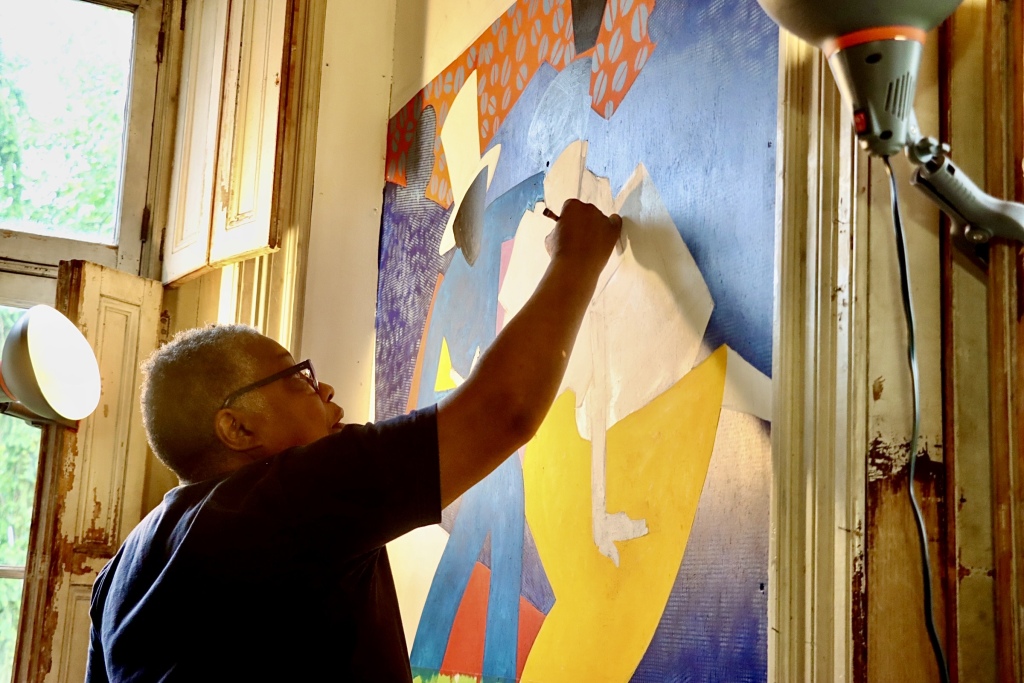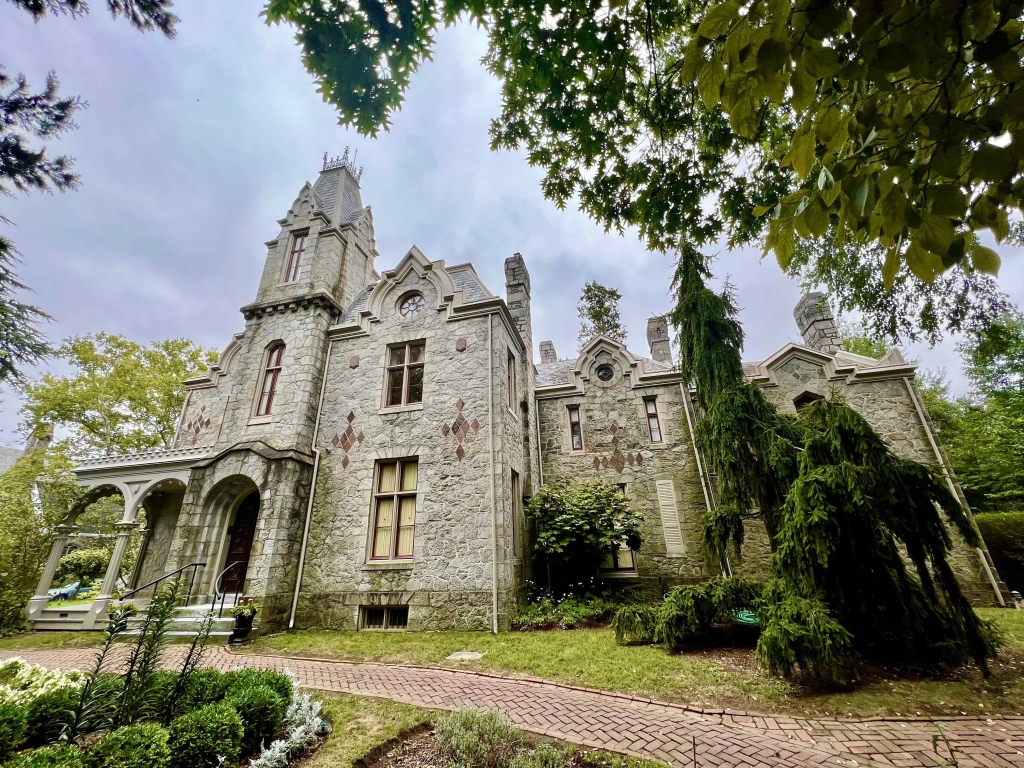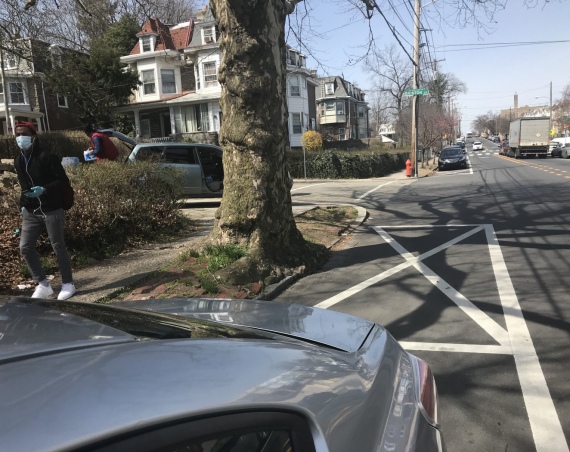
The Ebenezer Maxwell Mansion is one week from unveiling a new addition to its Deep Rivers tour. It will come in the form of a new mural painted by neighborhood artist Linda Gail Sanders celebrating the historical triumph of Black Americans, specifically focusing on the historical figures mentioned on tour.
Deep Rivers is short for Deep Rivers: How African Americans Waded through the Waters of Oppression to Achieve Greatness in the 19th Century. The name is inspired by the traditional African-American spiritual performed initially by the Fisk Jubilee Singers in the 1800s, which guests can hear a rendition of by Takeyla Brothers during their visit. The tour focuses on the achievements of Black folks in the 19th Century, such as John Trower, who is credited as the most important caterer in Philadelphia, Eliza Ann Greer, the first Black woman to receive a medical license in Georgia, and Elizabeth Keckly, who was the seamstress and speculated confidant of First Lady Mary Todd Lincoln. These names and more are the subjects of the ongoing scenic painting that spans across the walls of a room on the second floor of the Mansion.
The executive director at the mansion, Diane Richardson, says the idea to commission the artwork came more than a year ago and was decided by the Black History Advisory Board. They only needed to find an artist who came to them in a very neighborly way.
“We were looking for an artist,” Richardson said. “And you know, you wanted an African-American person. Someone on our Black History Advisory Board, Regina Robinson, walked their dog with Linda Gail Sanders. Then Linda showed her an image on her phone of some art she had done because she wanted input, and Regina recognized her as a great talent that could do the art.”
The Mansion hired the founder of Past Present Projects, Heather Moqtaderi, as curator for the new Deep Rivers art piece. In 2018, she was the curator of Victoriana Reimagined at the mansion. Next week, she will discuss the new piece in the mansion’s garden with Sanders. The primary goal of the conversation is to allow the audience to hear some of the stories and insights she’s been able to incorporate into her process.
“Every time I talk to Linda about this, I learned something new,” Moqtaderi said. Learning about the historical figures was one of her favorite parts of this process, but seeing Sanders probe her work and find solutions was special. She says, “this whole thing has been about finding solutions and figuring out how to bring contemporary art into a space that properly acknowledges the role of these individuals.”
Moqtaderi is also producing an audio tour accessible to people through their smartphones. The audio tour will allow people to hear Linda’s story at the installation when she isn’t present.
The artist, Linda Gail Sanders, made it her mission to ensure joy and celebration were at the heart of this project. While the subjects of the painting did not know each other, they are depicted as celebrating together. Sanders strives to separate the repetitive narrative of struggle that is commonly the dominant theme in discussing Black American history.
“That’s the thing I try to get away from when we’re talking about African Americans and their history,” Sanders fiercely exclaimed. “You always focus on the bad stuff. But these people made it through the oppression–they succeeded. They didn’t know each other, but in my pictures, they’re celebrating themselves.”
The mural’s setting takes place in what Sanders reimagines as John Trower’s catering company, now the Crab House on Germantown Avenue. Each figure is characterized by its historic achievement. John Trower serves food to Julian Francis Abele, who works with maquettes to design a new structure. Elizabeth Keckley is depicted in a vibrant party dress that would have historically been for First Lady Mary Todd Lincoln. And Francis Johnson, composer of The Grave of the Slave, is illustrated playing his keyed bugle which escorts the bodies of deceased enslaved people to heaven. These are just a few examples of a larger celebration of life and accolade that Sanders depicts.
Color contrast plays a huge role in the creation of the mural. Moqtaderi says, “I think that this piece expresses the binary of darkness and light explicitly. Her accomplishment and understanding of color theory is impactful in this piece. The colors vibrate because of the contrasts that [Sanders] is putting together between darkness and light and colors that are opposite of one another on the color wheel.”
Sanders draws from the inspiration of Jazz music and African art. African art, she says, “fuels the imagination,” while Jazz music is an epicenter of celebration. Sanders talks about how Black folks have traditionally resisted oppression through festivity.
“Black people love parties, and partying is a celebration of life,” she said. “Music is everywhere all the time. You can’t even go outside and take a walk without hearing somebody blasting music–and that’s where I get my inspiration from.”
Interestingly enough, another person Sanders thinks about when she considers what true celebration is is the late great Sylvester. Sylvester, who earned the “Queen of Disco” moniker, forged hits in the late 1970s and 1980s like “You Make Me Feel (Mighty Real),” “Don’t Stop,” and “Dance (Disco Heat).” While there were examples of other male-identified artists who were flamboyant, Sylvester was openly gay. He had an androgynous persona, often wearing women’s clothing when it was illegal in public. Sylvester is often attributed as one of many queer people who helped to challenge social norms throughout U.S. history — and it was primarily done by uniting people on the dance floor.
Sanders details her admiration for Sylvester, saying, “When his music came on, everybody just got up and just went to the floor. And then you would feel this energy. I never felt that before, and I kept feeling it over the years. And you know, that’s what celebration is about. There’s that invisible energy that rises from everybody. The energy from everybody fusing together, and everybody’s just having such a great time. And that’s magical.”
She sums up her inspiration from Sylvester by saying that he was free, which, for her, is true celebration.
When asked how she feels about crossing the finish line next week, Sanders says she’s excited to get back to her other work, as this project has helped her address questions and explore new processes as solutions to complete some of her other work. “I know how to do it now,” she says. “I’m anxious to get back to my work to see whether it’s going to take me as long, but I don’t think it is.

The new Deep Rivers mural unveiling will take place Saturday, September 17, at 2 p.m. For the first hour, groups will be admitted at twenty-minute intervals to see Sanders’ creation. The program will begin at 3:00 p.m. with a trumpet solo by Marell Bellinger. Following the solo, Moqtaderi and Sanders will converse about the new Deep Rivers piece. As a special nod to John Trower and Abby Fisher, there will be an ice cream social with brandied peaches as one of the toppings, as the ice cream is attributed to Trower and peaches to Fisher. Admission is free but limited, so grab your tickets while they last.
For those unable to attend next Saturday, the mural will be available to view every Friday from 11:30 a.m. to 2:00 p.m. through December and then again starting February 2023. Additionally, there will be a curator’s talk on Saturday, November 12, at 1:00 p.m. Be on the lookout for tickets, as this is also free but limited.



